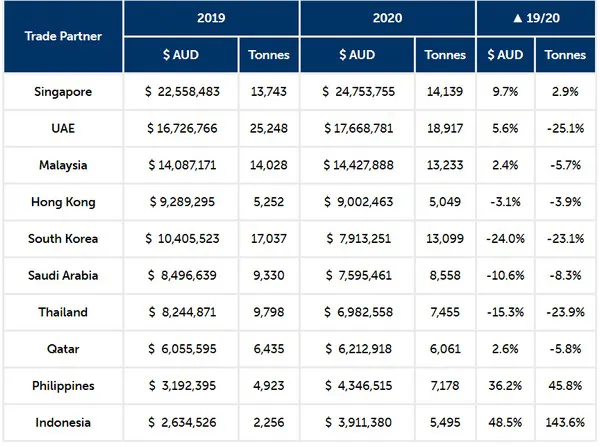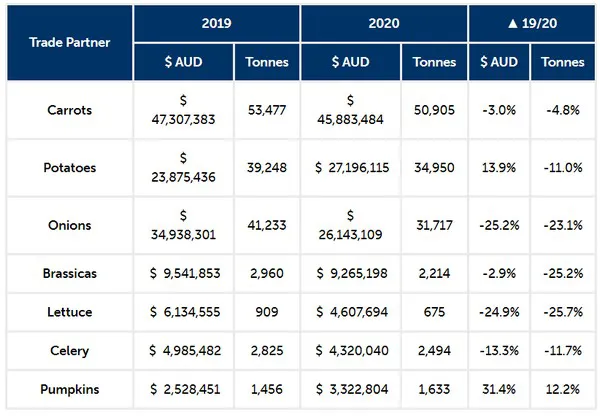The following update outlines the vegetable industry’s export performance in the first half of 2020, and AUSVEG’s export activities under the Hort Innovation-funded Vegetable Industry Export Program (VG16061).
This month’s update also provides a summary of fresh vegetable trade data from January to June 2020, as well as an update of AusTrade’s Export Market Development Grant (EMDG) program.
With a number of vegetable export crops facing challenges during the first half of 2020, the vegetable export supply chain proved resilient with over 126,000 tonnes of fresh vegetables shipped to international markets during the COVID-19 pandemic.
Exports by Destination Market
Singapore remained the top export destination for Australian vegetable exports, with an increase in value in the first half of 2020 by 9.7 per cent from $22.5 million to $24.7 million; export volume was up by 2.9 per cent from 13,743 tonnes to 14,139 tonnes.
The United Arab Emirates (UAE) rose 5.6 per cent in value but experienced a decline of 25 per cent in volume. Malaysia saw a similar trend, with a rise in export value of 2.4 per cent and a decline of 5.7 per cent in volume. South Korea experienced the largest decline in trade of the top export markets, with an average drop of 24 per cent in both value and volume.

Table 1: Change in vegetable exports by destination market January to June 2019-2020
Exports by Crop
For the first half of 2020, root vegetables such as carrots, potatoes and onions continued to ship significant export volumes. Notably, potato export value increased from $23.8 million to $27.2 million, nearly 14 per cent up on the same period in 2019. Pumpkin is the only vegetable that has recorded an increase in both export value and volume. Pumpkin exports grew by 31.4 per cent, from $2.5 million to $3.3 million and an extra 170 tonnes in volume from 1,456 tonnes in 2019 to 1,633 tonnes in 2020.
The figures in Table 2 below outline the total exports for the January to June 2020 period, but do not highlight monthly fluctuations for different crops exports. Over the course of these six months, perishable air freighted products saw a drop in exports on a month to month basis, albeit with some exceptions for certain crops into specific markets. Generally, sea freighted hard vegetable products performed better than the perishable vegetable exports; however, carrots, potatoes and onions also experienced some fluctuations in trade volumes from month to month.

Table 2: Vegetable exports by crop January to June 2019-2020
Export Readiness & Training
AUSVEG and the Export Council of Australia (ECA) have recently launched a new online e-learning training program for aspiring vegetable exporters.
The Export Fundamentals for Australian Fruit & Vegetable Growers: From Farmgate to International Markets course contains 11 e-learning modules covering a broad range of topics relating to international trade for fresh produce. Topics include Export Planning, Export Documentation, Market Access, Market Entry Strategies, Freight & Logistics, Export Finance & Pricing – click here for more information.
This online training program is suitable for vegetable growers not currently involved in export, vegetable growers who do export but want to improve their export knowledge, and experienced vegetable exporting businesses who want to develop the practical export skills of staff members. Access to this training course for National Vegetable Levy paying growers is funded by Hort Innovation using the vegetable research and development levy and funds from the Australian Government.
To register for this course visit www.ausveg.com.au/export and complete the online registration form under the ‘Export Readiness’ tab. For further information contact the AUSVEG Export Department via export@ausveg.com.au .
Click here for the full release
